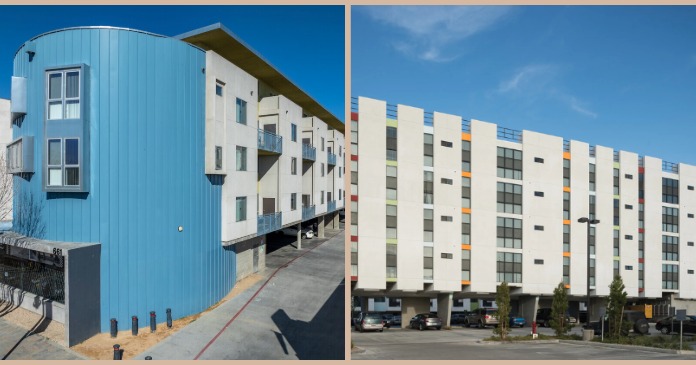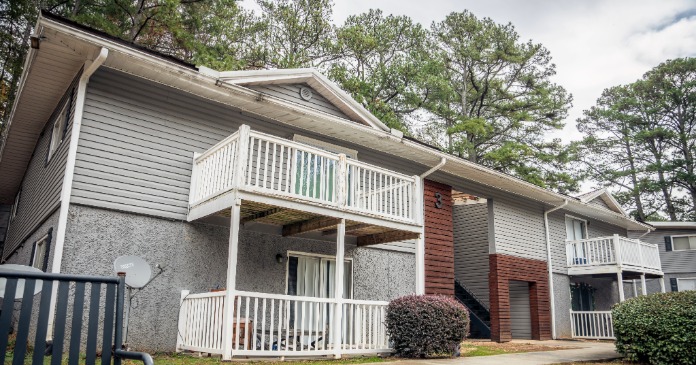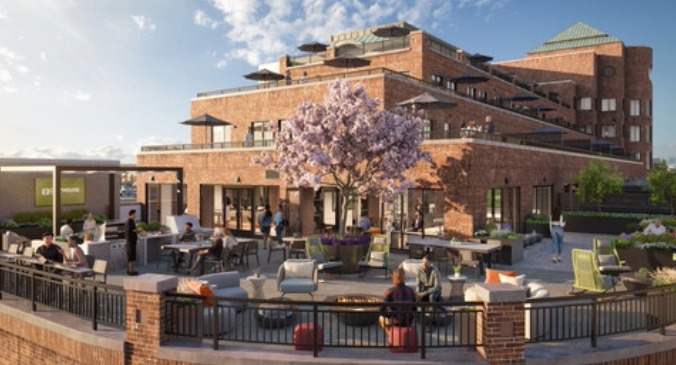Yield PRO TV presents NAHB Power Hitters. Host Linda Hoffman talks with John Thatch, Senior Vice President of Design Innovation for DAHLIN Architecture | Planning | Interiors.
Transcript: NAHB Power Hitters interview. Linda Hoffman with John Thatch recorded November 17, 2022
(music)
Linda Hoffman: I bet you can feel the tension. The divide grows. Classic or nouveau. Greek revival or Brutalist. Truth or relativism. From the beginning truth has battled the next generation of thinkers, thought leaders and designers. Every next gen innately seeking to make its own mark on the world. And like high school seniors leave behind a token of their moment in time.
Few of these big thoughts last and, if lucky, some find their way into history becoming ageless humor like mullets, blow-up chairs and furbies. Ah! the exuberance of youth. If you’re with proximity of Silicon Valley you’ve witnessed the newest fads, vacuity and restless souls come and go as fast as time on the allegorical beach in M. Night Shyamalan’s movie, Old, where time is accelerated and whole lifespans are compressed into a couple of days.
I just read an article in Forbes that referred to benchmarking as “large company conservatism.” Paralysis by analysis and most hated by young, fast moving start up CEOs and institutional VCs. Okay. Best practices emerged through time because they led to successful outcomes, value was created for the market and then rewarded by the market. Best practices mitigate risk. It’s also an opportunity to articulate an idea’s strengths and address areas for improvement.
Today’s guest understands the value of design and its need to solve the problems of time. John Thatch is senior principal with the Dahlin Group. Now an international firm, Dahlin began in the San Francisco Bay Area, East Bay to be precise in 1976 with a number of notable projects with which I am greatly familiar… Round Hill, Blackhawk, Behring.
John it is great to have you on the show.
John Thatch: Well, thank you for having me. I’m really appreciative of being here and being to talk to you about things. Look forward to your questions and proceeding with our conversation.
Linda Hoffman: Well, John, I just learned that you were employee number one at Dahlin. That’s amazing.What do we need to know about you—what else—and the Dahlin Group?
John Thatch: Well, I think the big thing about me is, again, I became an architect because, I guess, wanting the make the world a better place. And didn’t know what architecture until really I joined Doug Dahlin in 1976. And it was an interesting period. I didn’t expect it was just Doug I was joining when I came up north from San Luis Obispo. But it’s been a great journey. I’ve been really able to carve my own journey you know with Doug as far as what we do as architects and what we do as planners about really creating communities and creating housing for people and all the other items that go along with community design that we’ve been a part of as our firm has grown to this day.
Linda Hoffman: Dahlin is committed to sustainability, and you ascribe to the LEED standard. Some studies show mixed results on LEED and realized energy efficiency. What’s the design secret in ensuring that LEED features reduce energy use?
John Thatch: I think the thing is follow-up. You know, how are they working? You know a lot of the things we’re talking about are new, so we do a lot of follow up with clients. How are they working—or with homeowners, commercial clients—how it’s working. And it’s also to be a little bit out there on the forefront, talking with consultants and our clients about what’s new out there, what’s a possibility about what we can do.
So I think part of it is evaluation of new, of the past, but also evaluation of what’s possible in the future. Because it’s a big item as far as what we’re going to do as far as energy as our needs continue to grow, our population grows. It’s something just to take a look at—to evaluate and also look to the future at the same time.
Linda Hoffman: Sounds like benchmarking.
John Thatch: I think it’s a little bit of that as far as looking at things and being aware of things. I think being an architect or being a designer—a big thing is just being aware of your environment—not just what you do from a day-to-day basis, what other people are doing, not only like I said regionally, but nationally, but you mentioned more of an international firm. Well, I think you talked about benchmarking, I think it is. I think it’s knowing what the basis and knowing; you know evaluating what’s been done before.
But it’s also again looking out there, what’s new, what’s regionally, nationally. And like I said a big thing for our firm like you mentioned earlier that we do international work, and that’s really opened a lot of doors for us—about looking at things, evaluating things, and I think as designers I think we’re always you know looking out there as far as what’s new, what’s possible. But also a big part of that is valuation, you know, at the beginning and then afterwards.
Linda Hoffman: Are you aware of any developments underway to make LEED more predictive of real-world results?
John Thatch: I’m not going to say specific ones, but I think most are. I think most of our developer clients are looking after the fact because part of it is you know LEEDs does cost money. Looking at different avenues, what it does—and they want to have a valuation of what you’re doing and also—I mean—their projects, how they’re talking to people about it. They want to be able to say this has a benefit for you, what we’re doing has a benefit.
So, I think most developers are looking at that as a cost and also how to market it. We need to say prove it and look at it. So, most of our clients who are working with us are looking at that, as far as whether it’s an individual custom home or whether it’s a new community.
Linda Hoffman: You’re active in the NAHB. They promote the National Green Building Standard as a LEED alternative, at least for residential. Do you ever certify buildings to NGBS?
John Thatch: Yes, we do a lot of that with our clients. You know a lot of our clients prefer that. It’s not as cumbersome—a big thing about LEED is all the certification you have to do. The costs just to get certified, where the other program, NG, let’s say is more practical for builders. You know, builders have a lot on their plate to build these houses, you know, getting entitlements and building them and finance. There’s a lot on a plate for a development to get built.
Linda Hoffman: Tiny houses are proffered to answer the high cost of housing. Dahlin recently won a design competition for a tiny house project in Salt Lake City called MOD HIVE. Was this built and what are the challenges in entitling tiny houses?
John Thatch: It’s not built yet. We sort of, it was just an open competition. We picked a site that was next to a transit site. We picked our own site in Salt Lake City about where to do this and we thought would be appropriate you know, near transit. You know, looking at economic levels that the residents would have—that it’d be good to have transit, public transit close to them.
As far as what we’re doing elsewhere, we’re doing a lot of tiny homes and they’ve been in conjunction with some church law, we have First Presbyterian Church in the Bay Area in Castro Valley to be specific—Pastor Jake, who’s been great. He’s looking at working with other churches and parking lots in developing tiny homes in those areas. And really working—which I think is great—with parking lots for religious organizations that can also give services to, for the people in the tiny homes to really get people back on their feet. And it’s been very rewarding and has had challenges because it is something different a far as trying to break the mold, but it’s still fixed with bathrooms and kitchens.
But we’re getting through with a lot of communities and the more we do I think the easier it will be elsewhere we do. But we’re also looking at whole communities with Pastor Jake, which I can’t talk about yet, but how we can do whole communities like MOD and what we can do in the future.
Linda Hoffman: That’s exciting. I want to hear more about that. Hopefully we can have you back.
John Thatch: Well, thank you. I think it’s a great avenue. It’s something that’s very, again, like I said, how we make this place a better world. How we house people. There’s a lot of people who really need some help, a helping hand, as far as really get them started and help them into their futures.
Linda Hoffman: So, do we have more tiny houses in our future or is this just a moment in time?
John Thatch: Yes. I think there’s definitely a future for tiny homes and how it goes. And our population continues to grow, you know, we’re running out of land in certain areas where people want to live. And how do we provide, you know it’s a little bit of a kickstart for people as far as housing. And I think it also, long-term, it has some possibilities for long-term housing for maybe singles and things that can be converted to—you know like sort of a new apartment type life as far as something you want to have and how people want to live.
Linda Hoffman: I understand that you have a special interest in senior housing, John. That is a broad field. How are senior living designs changing, particularly post COVID?
John Thatch: I think their changing and trying to make them more healthier. We have a lot of things that we’re looking at: how does a home work for, say, people still at home. How does it, you know, entry areas that may be can be a little cleaner—this transition area of the house. How we, maybe look at bathrooms little differently. Also I think the big thing is getting more engaged in universal design. You know, how people can age in place.
I’m sort of going through that with my dad. He’s living in a two-story house and at 92 he finally moved downstairs. Not upstairs and how it’s been interesting for me to go through that with him and with making his house you know work for him now. He just turned 94 this week, you know, how that can work for him. So, I personally am at the moment, I know people want to live in their houses, and then maybe now we design new homes or how we do new retrofits. How we make that you know a long-term, that they can live in the house… I should say, how they can live in the house and make it you know very fruitful for them.
Linda Hoffman: Well, happy birthday to Mr. Thatch.
John Thatch: Yes, and I think that the other thing is again, just looking at different types of houses, whether, how we, you know, affordable, senior care, you know there’s a lot of people out there. We’re doing a lot of work that’s on the affordable side, and we’re also doing the high-end and sort of the middle but how I think universal design and how we create houses that you know are going be very rewarding for people as they get older.
Linda Hoffman: We have a long way to go on the senior housing.
John Thatch: Yes, there’s again like the affordable side there’s a lot of needs on all types of age brackets.
Linda Hoffman: Great show John. You learn something new every day. Thanks for coming on.
John Thatch: Well, thank you. I’m very appreciative of you allowing me to participate, so thanks.
Linda Hoffman: Time will tell. That’s a hard fact. Design and economies and trends remain in the eternal battle for relevance and value. And this may be one of the most fascinating times of all.
Thank you for joining us today. We hope you enjoyed the show. My editor in chief Michael Rudy and I are in the process of writing a book on the pillars of the industry… those builders, developers and operators who—through time—have made a genuine and valuable mark on the industry and multifamily housing.
The working title, most appropriately is GRIT. Makes sense to me. If you know of someone—and we’re looking for those with a serious track record, the battle born—please reach out as we work to capture the successes, and the lessons and the strategies that have made our nation’s multifamily housing great. Until then, see you on our next exciting episode of NAHB Power Hitters.
(music, close, credits)
NAHB POWER HITTERS (logo)
In association with National Association of Home Builders (logo)
Building Homes, Enriching Communities, Changing Lives
Yield Pro TV (logo)
An Image Production
Host Linda Hoffman
Executive Producer Andrew Nicks
Research Michael Rudy
Guest selection and coordination Dean Schwancke
Production Image
Yield Pro TV is a production of Multihousing Professional magazine corporation and may not be reproduced or copied in whole or in part without the expressed permission of the publisher.
©2023 Yield Pro, LLC.












